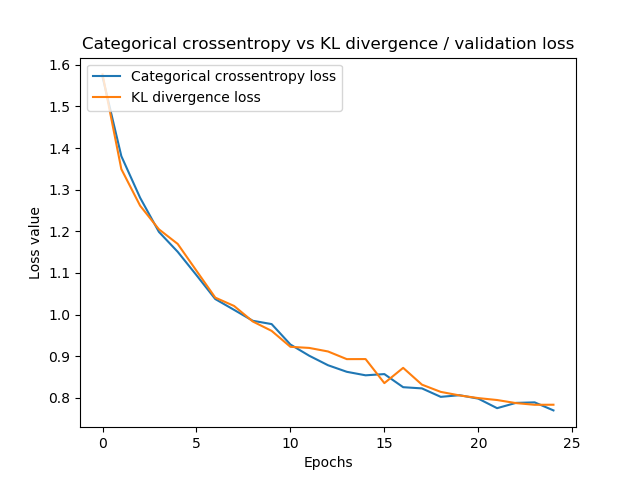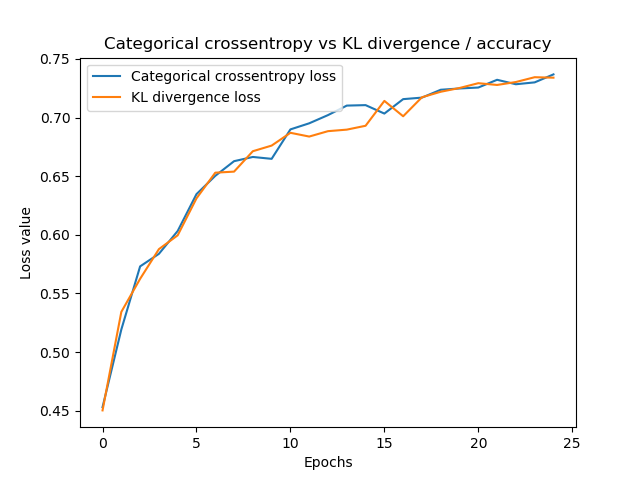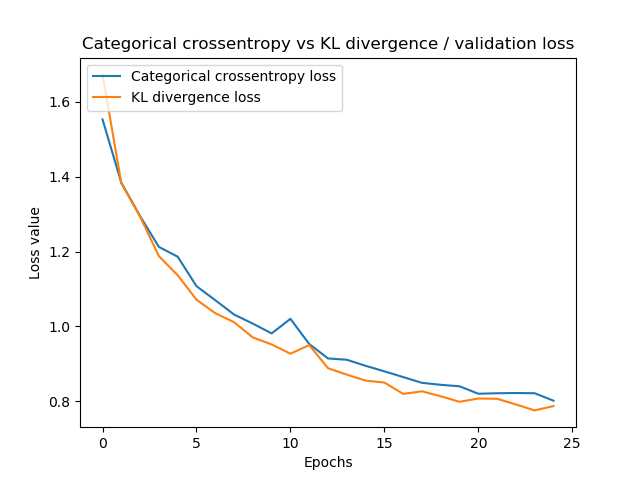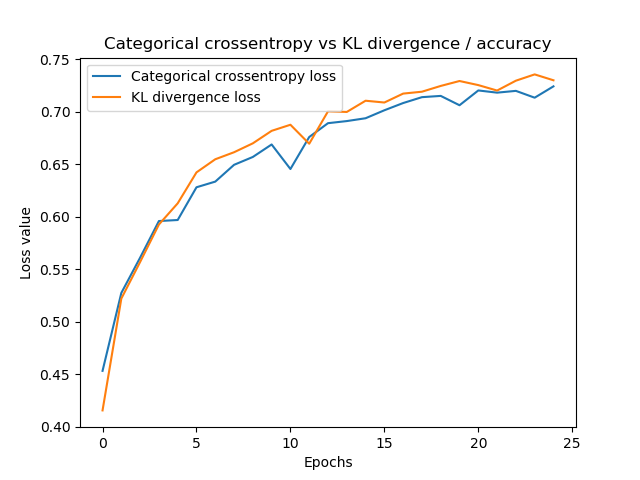How to use Kullback-Leibler divergence (KL divergence) with Keras?
December 21, 2019 by Chris
When you train a supervised machine learning model, you feed forward data, generating predictions on the fly. The comparison of these predictions with the actual targets valid for the samples used during training can be used to optimize your model.
But how to compare? That's a valid question.
There are various so-called loss functions these days, which essentially present you the difference between true target and prediction. The Kullback-Leibler divergence (or KL Divergence for short) is one of these. Seeing it in the Keras docs spawned a lot of questions. What is KL divergence? How does it work as a loss function? In what kind of machine learning (or deep learning) problems can it be used? And how can I implement it?
All valid questions which I'll try to answer in this blog article. First, I'll discuss what the KL divergence is - and (spoiler alert) - it's nothing more than a comparison metric for two probability distributions. Subsequently, I'll cover use cases for KL divergence in deep learning problems. This is followed by a look at the Keras API, to find how KL divergence is defined in the Losses section. Finally, we implement a Keras model with a KL divergence loss value, find out see how it works.
Are you ready? Let's go!
Comparing two probability distributions: KL divergence
Okay, let's take a look at the first question: what is the Kullback-Leibler divergence?
When diving into this question, I came across a really good article relatively quickly. At Count Bayesie's website, the article "Kullback-Leibler Divergence Explained" provides a really intuitive yet mathematically sound explanation in plain English. It lies at the basis of my attempt at explaining the KL divergence, augmented with a few extra sources. However, I definitely recommend taking a look!
Small note: contrary to Count Bayesie's article, I'll start my discussion from a supervised machine learning point of view.
ML based probability distribution
Suppose that you have a probability distribution. Some activation functions do that, such as the Softmax activation function, that generates a probability distribution over the classes in your supervised machine learning setting.
Now what if, contrary to the Softmax situation where the categorical crossentropy loss function is often used which only takes into account the argmax of the predictions generated, you wish to compare the predicted distribution with some actual distribution?
As we will see, there are situations when this happens. In those cases, you can use the Kullback-Leibler Divergence, which is an adaptation of the entropy metric that is common in information theory (Count Bayesie, n.d.).
From entropy based information size to expected information loss
But what is entropy? Mathematically, it can be defined as follows (Wikipedia, 2001).
\begin{equation} H(X) = -\sum p(X)\log p(X) \end{equation}
Intuitively, it's the expected value of the probability of data in some distribution. In plain English, it's something like this (assuming that \(log_2\) is used): "the minimum number of bits it would take us to encode our information" (Count Bayesie, 2017).
The entropy for some probability distribution thus tells you, given some data, how much information is in it. Knowing this, we can also find out how much is lost when you change the distribution.
Because that's what you do when you're performing deep learning activities: your feedforward-generated predictions effectively form a probability distribution ("there is some probability that the value lies between \(x\) or \(y\) / takes value \(x\)"), and hence can be compared with the true distribution for the sample (i.e., your training dataset).
Now - if your optimizer adapts its weights, the predictions change, and so does the probability distribution generated by your model. If only you could measure the loss of information between the model-based probability distributions and the distribution of the actual training dataset... then, you could do some optimization.
KL divergence
Well, you can!! 😎
By slightly adapting the formula for entropy, we arrive at the Kullback-Leibler divergence (Count Bayesie, 2017)! It can be defined as follows (Wikipedia, 2004):
\begin{equation} KL (P || Q) = \sum p(X) \log ( p(X) \div q(X) ) \end{equation}
In plain English, this effectively tells you how much entropy you lose or gain when you would change probability distributions (recognize that \(\log ( p(X) \div q(X) ) = \log p(X) - \log q(X)\), Count Bayesie 2017).
It's hence not surprising that the KL divergence is also called relative entropy. It's the gain or loss of entropy when switching from distribution one to distribution two (Wikipedia, 2004) - and it allows us to compare two probability distributions.
Let's now take a look which ML problems require KL divergence loss, to gain some understanding when it can be useful.
Use cases for KL divergence in machine learning problems
But when to use KL divergence in your machine learning projects?
Based on some Googling, I found that there are some use cases when Kullback-Leibler divergence is quite useful:
- Primarily, it is used in Variational Autoencoders (Count Bayesie, 2017; Shafkat, 2018). These autoencoders learn to encode samples into a latent probability distribution. From this latent distribution, a sample can be drawn that can be fed to a decoder which outputs e.g. an image. It's one of the types of generative models currently being fashionable for generating e.g. pictures of humans (although strictly speaking, for the linked blog a different type of model - a GAN - has been used).
- However, KL divergence can also be used in _multi_class classification scenarios (Moreno, n.d.). These problems, which traditionally use the Softmax function and use one-hot encoded target data, are naturally suitable to KL divergence since Softmax "normalizes [data] into a probability distribution consisting of K probabilities proportional to the exponentials of the input numbers" (Wikipedia, 2006). In plain English: the output tells you, for some sample \(x\), the odds of being present in the input image. Since KL divergence works with probability distributions, it's very much usable here.
- Funnily, KL divergence is also used for replacing Least Squares minimization in models (Kosheleva & Kreinovich, 2018). In regression models, the loss function to minimize is usually the error (prediction minus target), often squared. While the simplicity of such loss functions pays off in terms of efficacy, they are notoriously sensitive to noise (especially when the predictions generated by the feedforward operation are everything but part of the normal distribution). Rather counterintuitively, KL divergence has appeared here as an interesting replacement - as it works on the distribution level rather than the sample level.
Kullback-Leibler divergence in the Keras API
The Keras API defines the KL divergence as follows (Keras, n.d.):
keras.losses.kullback_leibler_divergence(y_true, y_pred)
This means that it can simply be defined as 'kullback_leibler_divergence' in your models. Simple :-)
Implementing a Keras model with KL divergence
Let's now see whether it's possible to implement a model with Keras that makes use of the KL divergence. As we've seen, it's possible to use KL divergence in some ML problems - and multiclass classification with Softmax function is one of them, because it generates probability distributions. These can be compared with KL divergence, and hence training can take place with it.
We'll therefore slightly adapt a ConvNet created in another blog post to use KL divergence. This way, you don't have to immerse yourself in an entirely new model (assuming that you've read the linked post) yet can see how KL divergence can be used with Keras.
Configuring the loss function during Keras model compilation
And it's simple, actually. It just involves specifying it as the used loss function during the model compilation step:
# Compile the model
model.compile(loss=keras.losses.kullback_leibler_divergence,
optimizer=keras.optimizers.Adam(),
metrics=['accuracy'])
That's it!
Full Keras CNN code
Here's the full ConvNet code, including KL divergence:
import keras
from keras.datasets import cifar10
from keras.models import Sequential
from keras.layers import Dense, Dropout, Flatten
from keras.layers import Conv2D, MaxPooling2D
from keras import backend as K
# Model configuration
img_width, img_height = 32, 32
batch_size = 250
no_epochs = 25
no_classes = 10
validation_split = 0.2
verbosity = 1
# Load CIFAR10 dataset
(input_train, target_train), (input_test, target_test) = cifar10.load_data()
# Reshape data based on channels first / channels last strategy.
# This is dependent on whether you use TF, Theano or CNTK as backend.
# Source: https://github.com/keras-team/keras/blob/master/examples/mnist_cnn.py
if K.image_data_format() == 'channels_first':
input_train = input_train.reshape(input_train.shape[0],3, img_width, img_height)
input_test = input_test.reshape(input_test.shape[0], 3, img_width, img_height)
input_shape = (3, img_width, img_height)
else:
input_train = input_train.reshape(input_train.shape[0], img_width, img_height, 3)
input_test = input_test.reshape(input_test.shape[0], img_width, img_height, 3)
input_shape = (img_width , img_height, 3)
# Parse numbers as floats
input_train = input_train.astype('float32')
input_test = input_test.astype('float32')
# Normalize data.
input_train = input_train / 255
input_test = input_test / 255
# Convert target vectors to categorical targets
target_train = keras.utils.to_categorical(target_train, no_classes)
target_test = keras.utils.to_categorical(target_test, no_classes)
# Create the model
model = Sequential()
model.add(Conv2D(32, kernel_size=(3, 3), activation='relu', input_shape=input_shape))
model.add(MaxPooling2D(pool_size=(2, 2)))
model.add(Dropout(0.50))
model.add(Conv2D(64, kernel_size=(3, 3), activation='relu'))
model.add(MaxPooling2D(pool_size=(2, 2)))
model.add(Dropout(0.50))
model.add(Flatten())
model.add(Dense(256, activation='relu'))
model.add(Dense(no_classes, activation='softmax'))
# Compile the model
model.compile(loss=keras.losses.kullback_leibler_divergence,
optimizer=keras.optimizers.Adam(),
metrics=['accuracy'])
# Fit data to model
model.fit(input_train, target_train,
batch_size=batch_size,
epochs=no_epochs,
verbose=verbosity,
validation_split=validation_split
)
# Generate generalization metrics
score = model.evaluate(input_test, target_test, verbose=0)
print(f'Test loss: {score[0]} / Test accuracy: {score[1]}')
Results
I ran the model twice, then changed to categorical crossentropy loss, and ran it twice too. This allows for some comparison between KL divergence and categorical crossentropy loss, which is normally used in multiclass classification with one-hot encoded vectors.
In 25 epochs, performance is very similar. Therefore, I'd say you could use both if you're facing the choice when to use categoricall crossentropy or KL divergence.
Summary
In this blog, we looked at what KL divergence is and how it can be used in neural networks. To illustrate this, we created an example implementation of a convolutional neural network, created with the Keras deep learning framework in Python. This example, which makes use of KL divergence loss, performs equal to traditionally-used categorical crossentropy loss.
I hope you've learnt something from this blog post, even though it's a bit shorter than usual. If you did, I'd love to know - so feel free to leave a comment in the comments box below! Please also do so when you have questions or when you spot mistakes in my text. I'll happily improve it and will then list you in the references list 😊
Thank you for reading MachineCurve today and happy engineering! 😎
References
Count Bayesie. (2017, May 10). Kullback-Leibler Divergence Explained. Retrieved from https://www.countbayesie.com/blog/2017/5/9/kullback-leibler-divergence-explained
Wikipedia. (2004, February 13). Kullback–Leibler divergence. Retrieved from https://en.wikipedia.org/wiki/Kullback%E2%80%93Leibler_divergence
Wikipedia. (2001, July 9). Entropy (information theory). Retrieved from https://en.wikipedia.org/wiki/Entropy_(information_theory)
Shafkat, I. (2018, April 5). Intuitively Understanding Variational Autoencoders. Retrieved from https://towardsdatascience.com/intuitively-understanding-variational-autoencoders-1bfe67eb5daf
Kosheleva, O., & Kreinovich, V. (2018). Why deep learning methods use KL divergence instead of least squares: a possible pedagogical explanation. https://digitalcommons.utep.edu/cs_techrep/1192
Moreno. (n.d.). Alexander Moreno's answer to What are some applications of the KL-divergence in machine learning? Retrieved from https://www.quora.com/What-are-some-applications-of-the-KL-divergence-in-machine-learning/answer/Alexander-Moreno-1
Keras. (n.d.). Losses. Retrieved from https://keras.io/losses/#kullback_leibler_divergence
Wikipedia. (2006, July 28). Softmax function. Retrieved from https://en.wikipedia.org/wiki/Softmax_function

Hi, I'm Chris!
I know a thing or two about AI and machine learning. Welcome to MachineCurve.com, where machine learning is explained in gentle terms.
Getting started
Foundation models
Learn how large language models and other foundation models are working and how you can train open source ones yourself.
Keras
Keras is a high-level API for TensorFlow. It is one of the most popular deep learning frameworks.
Machine learning theory
Read about the fundamentals of machine learning, deep learning and artificial intelligence.
Most recent articles
January 2, 2024
What is Retrieval-Augmented Generation?
December 27, 2023
In-Context Learning: what it is and how it works
December 22, 2023
CLIP: how it works, how it's trained and how to use it
Article tags
Most popular articles
February 18, 2020
How to use K-fold Cross Validation with TensorFlow 2 and Keras?
December 28, 2020
Introduction to Transformers in Machine Learning
December 27, 2021
StyleGAN, a step-by-step introduction
July 17, 2019
This Person Does Not Exist - how does it work?
October 26, 2020
Your First Machine Learning Project with TensorFlow 2.0 and Keras
Connect on social media
Connect with me on LinkedIn
To get in touch with me, please connect with me on LinkedIn. Make sure to write me a message saying hi!
Side info
The content on this website is written for educational purposes. In writing the articles, I have attempted to be as correct and precise as possible. Should you find any errors, please let me know by creating an issue or pull request in this GitHub repository.
All text on this website written by me is copyrighted and may not be used without prior permission. Creating citations using content from this website is allowed if a reference is added, including an URL reference to the referenced article.
If you have any questions or remarks, feel free to get in touch.
TensorFlow, the TensorFlow logo and any related marks are trademarks of Google Inc.
PyTorch, the PyTorch logo and any related marks are trademarks of The Linux Foundation.
Montserrat and Source Sans are fonts licensed under the SIL Open Font License version 1.1.
Mathjax is licensed under the Apache License, Version 2.0.



